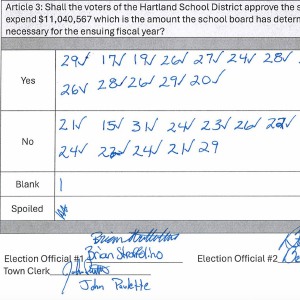Logging around Piermont lake will go ahead over objections of residents
| Published: 03-24-2023 4:22 PM |
PIERMONT — Finding no significant environmental impact in a controversial logging plan, the United States Forest Service is moving ahead with plans to log around Lake Tarleton.
Given the go-ahead, “management actions” for habitat, vegetation and recreation will occur within 755 acres of management land owned by the USFS, some of which surrounds Lake Tarleton, located in the towns of Piermont and Warren, N.H. The project is expected to begin this summer, if it makes it past one final objection period.
The land around Tarleton, which is the biggest lake in the White Mountains, is also home to the Kingswood Camp for Boys, three private residences, seasonal camps and two public access points.
“Silvicultural treatment,” as its referred to in the USFS decision — which includes clearcutting — would occur on 690 of those acres. Other “treatments” include commercial thinning and overstory removal.
“After acquisition of the Tarleton lands, the (White Mountain National Forest) allowed the landscape to grow and restock, (and) this timeframe has brought it into silviculture alignment with treating landscapes every 20–30-years as part of the habitat and forest management cycle,” USFS Pemigewasset District Ranger Brooke Brown wrote in a public letter addressing her decision. “It is now ready for active management to advance the Forest Plan’s goals, objectives, and desired conditions for vegetation as a working forest.”
In 2019, USFS first introduced the project to the public. The federal agency has received more than 600 individual letters commenting on the project, over three separate comment periods, in the time since.
Some residents and environmentalists opposed to the project, organized within the Lake Tarleton Coalition, pointed to the loss of the carbon sequestration capacity of undisturbed old-growth forest, and aesthetic damage to an iconic feature of the White Mountains.
“We appreciate some of the changes that the forest service has made in the draft record of decision, and we’re grateful that the forest service has met with local residents on multiple occasions over the past year,” said Zack Porter, a member of the coalition and the director of Standing Trees, a Montpelier-based nonprofit working to protect Vermont’s forests.
Article continues after...
Yesterday's Most Read Articles
 Hartland voters successfully petition for school budget revote
Hartland voters successfully petition for school budget revote
 JAG Productions announces closure, citing ‘crisis facing the arts’
JAG Productions announces closure, citing ‘crisis facing the arts’
 Hanover’s Perreard may soon capture the attention of collegiate coaches in two athletic pursuits
Hanover’s Perreard may soon capture the attention of collegiate coaches in two athletic pursuits
“But we remain concerned that this project still doesn’t come close to honoring the vision that this community had for this landscape when the Lake Tarleton area was purchased from would-be developers and transferred to public ownership.”
Residents in the area are also known for defeating plans for a 5,000-home development in the 1970s and a resort in 1994.
In 2000, fundraising efforts garnered about $7 million to buy and protect over 5,000 acres around Lake Tarleton in Warren, Piermont and Benton in perpetuity. A few years later, the White Mountain National Forest was able to acquire the land from the Trust for Public Land.
“The community rallied to protect the lake and raised millions of dollars to do so with a vision that the forest around the lake would be protected as you see it now,” Porter said. “That’s how they raised that money back then, and that’s what the Forest Service said would be the future of the lake.”
As a result of public comment, the scale of forestry activities was reduced from 880 acres to 690 acres, according to the letter from the Forest Service. Also as a result of the comment period, a no-cut buffer around Lake Tarleton was extended from 100 feet — the minimum state and federal requirement — to 300 feet.
Proponents of logging point to its financial intake: Some revenue from the sales go directly to local towns, while 75% goes to the Forest Service for “forest improvement” and the U.S. Treasury. The logger also gives the town 10% of the total value of the timber. Forest management can also promote more diverse vegetation and wildlife habitat, and without active intervention, the Forest Service argues, the forest would trend towards homogeneity.
A 45-day appeal period for the draft decision began on March 16, and is only open to parties who had previously submitted comments on the project.
Objections can be filed at the following link: https://tinyurl.com/2p8cksr4
Frances Mize is a Report for America corps member. She can be reached at fmize@vnews.com or 603-727-3242.

 Over Easy: ‘A breakfast without a newspaper is a horse without a saddle’
Over Easy: ‘A breakfast without a newspaper is a horse without a saddle’ Lawsuit accuses Norwich University, former president of creating hostile environment, sex-based discrimination
Lawsuit accuses Norwich University, former president of creating hostile environment, sex-based discrimination In divided decision, Senate committee votes to recommend Zoie Saunders as education secretary
In divided decision, Senate committee votes to recommend Zoie Saunders as education secretary
